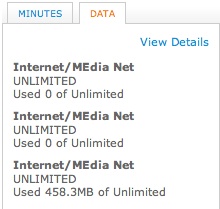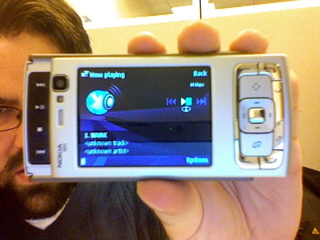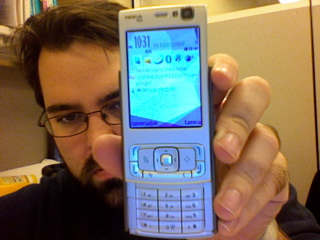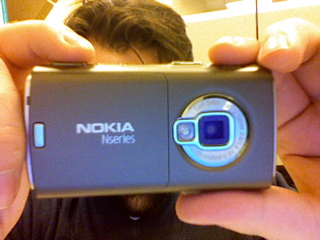The N95-3 is Nokia's flagship device, and it has everything you'd expect in such a thing.
The Camera
The N95 includes a 5 megapixel, autofocus, Carl Zeiss lens camera. We've all come to expect grainy, noisy cell phone pictures (hey, like the ones I've included on this review, which were taken with iSight), so the potential for something better is a big draw in the N95.
On this front, it largely lives up to my expectations - it's surely better than any other phone camera I've seen, though it's not really a match for current cameras. The autofocus is a bit sluggish, but works, and daytime images turn out beautifully. The colors are a bit "off" (when compared to my Sony DSC-N1), due to some extra image processing, but not by a whole lot. The flash is, sadly, LED - it's not as bad as I'd expected in terms of light output, but night pictures taken with the N95's flash still exhibit an unnatural blueish tint.
I ended up using the N95 almost exclusively when taking photos in New York, and you can see some examples in my gallery for that trip. With the exception of the first page (taken with my Nokia 6120 Classic) and the ones from the top of the Empire State Building (which begin with filenames "DSC" and were taken with my Sony DSC-N1), I did everything with the N95. I was so happy with the quality that I left the DSC-N1 in the hotel room for most of the trip.
Even more impressive, at least to me, was the quality of video shot with the N95. I couldn't discern any quality difference between that and the DSC-N1 in day-mode filming. It's a huge win in this department.
The only real disappointment I have with the camera is its horribly slow image processing speeds. The time between taking one picture and being able to take the next is frustrating, reaching 5 seconds or more. The same is true with the "warm up" time to actually take a picture once starting the camera app (which is done, by the way, by pressing and holding the camera key). Euro N95 owners, who have recently received a major firmware update, have reported that this is much improved with the new software. I'm hoping that at some point the US version will see some firmware love too.
GPS
The N95 was one of the first Nokia devices to ship with an integrated GPS, though it seems all of their recent high end devices are picking this up as well. I'll start by saying that Nokia's included mapping software is, essentially, crap - when I first used it I was immediately frustrated with the unresponsive UI and the useless search functions. Furthermore, the interesting features - voice navigation and route planning - are all unavailable unless you pay for a subscription service. Uh... no, I don't think so. Fail, Nokia.
For a while after I got the device, I barely even used the GPS, instead relying on maemo mapper and my N800. Luckily, google released an S60 native google maps a couple of months ago, which could finally utilize the GPS receiver. Google Maps is better than Nokia Maps in almost every way, except that it does not support automatic rerouting or voice directions (features that Nokia Maps only gives you if you pay extra anyway). I now use the GPS extensively, and enjoy having it.
In terms of sensitivity, I really don't have any complaints. I believe my GPSlim 240 gets a lock slightly faster, but the N95 does well enough. One quibble I have is that the N95 doesn't have the necessary bluetooth profile so that you can use it as an external GPS with a computer or the N800 - luckily this has been remedied with some third party software.
Internets
The interwebs are strong with the N95-3, there's no doubt. The "killer app" for this device is its support of both current North American HSDPA frequencies with its dual-mode 850 / 1900 WCDMA receiver. Due (at least in part) to some longstanding patent disputes, Nokia has yet to release a true HSDPA "world phone" - instead, they've got devices that support Euro 3G, and another device that supports American 3G. You read that right - the N95-3 is the only Nokia device to support US HSDPA.
So, is HSDPA all that it's cracked up to be? In a word, yes. Case in point: while in NYC, we had no free wifi available in our hotel. I did, however, have full bars and a little "3G" icon - so it was tethering time.
I downloaded several TV episodes from my MythTV box, easily capping out the upload on my cable modem. At the same time, I was browsing the internets - watching some youtubes and the like. I ran some speed tests - I was getting over 900 kbit/s, and 250 ms latency via HSDPA. Totally, completely awesome - finally, mobile broadband in a Nokia device. Tethering this thing to the N800 is incredible - it's almost as fast as wifi. And no, your iPhone can't do any of that. I checked my usage after that first day on AT&T's billing site:

Speaking of wifi, the N95 has it. It works. The UI is pretty crappy, but it gets the job done - honestly, though, if I have 3G I usually don't even bother unless I need to access network resources on a LAN. I don't notice much of a difference.
The S60 "Web" browser is pretty good. It's based on KHTML, and it calls itself safari - it has decent javascript support, and the navigation on it is about as good as you can imagine when relying on the d-pad. It's good enough for casual use, but the N800 and iPhone browsers kill it - if I know I'm going to be doing some serious interwebbing, I still bring the N800 along with me.
The S60 email client works fine - I've started using it with gmail instead of the special gmail client. It does waste a huge amount of space when displaying messages, though, forcing you to move through multiple pages where you might have only one using gmail's mobile web UI.
Multimedia
The N95-3, as an N series device, is advertised as a "multimedia computer" by Nokia. That may seem a little ambitious, but apart from a few annoying weaknesses it's not all that far from the truth.
The built-in music player does a fine job. It does some frustrating things - like, autoscanning your entire memory card, and automatically adding every music file it can play to your library - but it does a good job of putting music into your ears via your preferred method. It does, unfortunately, seem to have a low "hiss" when playing music, but it's not audible most of the time.
The player shows cover art, if it can - whether it can do so or not seems to depend on how the art is presented to it. From what I can tell, it can only display art that's imbedded in ID3 tags. No big deal really. It also supports non-DRM'd AAC and WMA files.
While the multimedia keys might be mostly useless, the volume rocker on the side of the phone is not. A dedicated, physical volume key is a nice thing to have.
The largest weakness in the music player is that it has no daap or UPNP support whatsoever. If you want to stream music from a local media server, you're just SOL - you have to copy the files onto internal memory.
Video fares a bit worse. Included is only realplayer, which can play back only a few specific formats. I tried in vain to master mencoder or ffmpeg's command line and generate files that work properly, but I had no luck - googling around, I discovered it was a solved problem, and found a little shell script that manages to spit out things the N95 likes. Once you give realplayer a file it can handle, it works fine, though it's not in any way impressive.
Photos work pretty well, but with the same (now even more annoying) frustrating behavior of showing every image on the entire device. Why can't I limit this to a single directory?
Other Nokia apps open up more multimedia possibilities. "Podcast," which is available from "Download!" works very well for downloading radio shows directly to the device over wifi or UMTS. "Internet Radio," also available via "Download!", allows you to stream shoutcast stations over UMTS or GSM as well as wifi.
Third party apps provide even more multimedia functions - EmTube, for example, allows you to play pretty much anything on youtube on the N95, and it works great with HSDPA. The N95 can browse the youtube mobile site and play those files out of the box, but EmTube opens up much more content that's not on the mobile site yet.
The N95 supports A2DP, and it works pretty well. I seem to have fewer issues than I did with the 6120C.
The 3.5 mm output jack is quite nice. You can use standard 3.5mm headphones with it, or you can use Nokia's proprietary remote control headphone cord, or you can even use Nokia's video+audio cable to send both video and audio to a device that support composite inputs (read, most modern TVs). TV out works really well, despite defaulting to PAL for some obscure reason (this N95 is sold exclusively in the North American market, so this is puzzling).
The built-in stereo speakers are decent, probably a bit better than my W600i. The laws of physics are obviously against them here, and anything this size will sound rather tinny, but these are probably the best speakers I've heard in a device this small. They work great for listening to NPR, but if you're planning to bust out some bass lines from Kanye West or Gangstalicious you're asking for a disappointing experience.
Everything Else
The N95 is still a phone, even with all of the other features. Its phone functionality is fine - much more easy to use than Windows Mobile device, at least in my opinion. Voice dialing is there, custom ringtones are there, etc. Where the phone wins is in its integrated SIP support, which allows you to use VOIP via wifi - or even HSDPA, if you're totally crazy.
Battery life is decent, but largely depends on how much you're doing. If I use the device constantly, I can drop the battery to nothing in a few hours. A spare battery or a device to recharge the thing in the field could be really useful investments. Hint - HSDPA is the true killer here, especially if you have a weak signal. Best to switch to GSM if you're trying to push the limits of your charge. A2DP also takes a huge toll on battery life. If I just use the thing like a phone and switch off 3G, it should last up to 3 days on a charge. But, your milage may vary.
The N95 has a special "diamond menu" that's launched by the button to the right of the d-pad. Unlike the other keys in the nav cluster, this is not found on most S60 devices, and it's peculiar to the N95 (and possibly some other newer N-Series devices - I need to verify that). This menu is worthless, since it loads slowly and does nothing the normal active standby screen can't do, and I find myself hitting the diamond menu by accident pretty frequently. I would much rather be able to map this key to something manually (hey, how about the music player!) that would be more useful.



